Intro of Art Scholarships
As a professional in art, you understand its value in honing one’s skills and building a comprehensive portfolio. Unfortunately, the cost of attending an art school or enrolling in further studies can be a burden. This is where art scholarships come into play. They offer assistance and relieve the financial strain that would otherwise come from carrying the weight of student loans.
This guide covers everything about finding and applying for art scholarships, whether you’re considering enrolling in an art program or have already started taking classes.
What Are Art Scholarships?
Art scholarships are financial grants offered to students pursuing their education in the field of art based on their artistic capabilities or financial need. These financial resources offered by private businesses, nonprofits, universities, or even governmental bodies can ease the burden of covering tuition costs at art schools, universities, and other educational institutions.
Types of Art Scholarships
Through merit-based and achievement-based criteria, art scholarships can be awarded in multiple forms. Familiarizing yourself with these criteria can increase your chances of getting selected for a particular scholarship.
Merit-Based Art Scholarships
Merit-based scholarships are given to learners who excel in a particular area of art. The requirements include submitting a portfolio of your artwork that has to be critiqued by a panel of experts or professionals in the filed. In most cases these scholarships are very competitive as they give the best rewards for the most talented artists based on skill and creativity.
Need-Based Art Scholarships
Need-based art scholarships are set to help students who cannot afford the tuition for an art school. They will have to prove their eligibility by submitting certain requested documents like a tax return form, family income or even FAFSA documents. But these scholarships are specially catered for individuals who are financially unable to afford education in art.
Program-Specific Art Scholarships
Some of them are awarded for very specific area in the arts, for example a scholarship can be awarded for learners studying fine arts or graphic design, digital media, animation and even music. For out there targeting advertisement might be looking at a specific discipline art and would want to offer sponsorships in that area to increase the chances foes winning the awards.
Who Can Apply for Art Scholarships?
Prior to beginning the application process for art scholarship opportunities, it is recommended that you familiarize yourself with specific eligibility requirements. These requirements tend to differ, but there are some general guidelines to consider.
Eligibility Criteria for Art Scholarships
1. Age Limit
The majority of art scholarships tend to cater towards high school students, undergraduates, and post-graduates, and some may even target post-graduate students. As with any scholarship, be sure to determine the maximum age and academic stage prerequisites.
2. Artistic Talent and Portfolio Submission
In the case of scholarships awarded on the basis of artistic merit, the applicant’s artistic ability will likely be the most important criterion. A portfolio depicting your exemplary work must be included. This may consist of drawings, paintings, sculptures, digital art, photography, or any other artistic discipline. Certain scholarships may have a specific requirement relating to the artistic theme, but many are more relaxed with the submission guidelines.
3. Financial Need
In the case of scholarships awarded on the basis of financial need, the applicant’s financial situation will be evaluated. To prove financial need, you must offer documents that verify your financial aid requirements. This is crucial in cases of students who are from economically disadvantaged families and require financial support to meet tuition, learning, and other living expenses.
4. Academic Requirements
Some scholarships for art programs include a prerequisite minimum GPA or academic standing. In general, most art scholarships only look at one’s artistic skills, but having a good academic record always helps. Make sure you do not breach any eligibility criteria that may lead to disqualification.
The Benefits of Winning an Art Scholarship
Art scholarships come with a lot more than just financial assistance, such as helping you plan your future career as an artist.
Financial Support for Your Education
The benefits of any scholarship include financial aid. Attending art school can be costly, and some scholarships provided enable easy payment of tuition, art materials, books, and even living costs. Securing these awards enables attending one’s dream schools, while avoiding massive debt.
Building Your Artist Portfolio and Recognition
Advancing Your Career Recognition Scholarship awards can play a pivotal role in building and improving your portfolio. Securing one shows commitment and endorse your talent. These self promotional benefits face no barriers when it comes to applying for internship programs, artist residency or any other place of work.
Opportunities for Networking and Career Advancement
Most of the scholarships come alongside networking functions, workshops, and even internships. Upon recognition, you will be exposed to a wide range of professionals and mentors, as well as other artists, which will serve as invaluable building blocks within the art community. These connections can assist you with employment, collaborative projects, or exhibition opportunities.
Types of Art Scholarships Available
Depending on the sponsors, geographic regions, and target audiences, art scholarships are bound to pop up in various unconventional forms. Here is an outline of some of the scholarship types you are likely to come across.
National vs. Local Art Scholarships
Students from all over the country can apply for these National scholarships which are usually provided by big businesses like corporations, organizations, or foundations. Although these are more competitive, the will poatally provide more funding. In contrast, local scholarships are usually offered by state governments, local businesses, or community groups.
Though these scholarships could be less competitive, they will have much less funding. However they present valuable chances for students in certain areas.
Scholarships from Art Schools and Universities
A large number of art schools and universities offer scholarships in a bid to attract talented contestable students. These scholarships, some of which are merit-based scholarships or need based, are sometimes given to students who wish to specialize in painting, sculpture, or digital design.
Private and Nonprofit Art Scholarships
Private companies along with nonprofit organizations and art foundations provide these non-government scholarships aimed at helping students interested in pursuing education in art. Such scholarships are open to students of certain artistic fields or those who show leadership or community service in the arts.
Scholarships for Different Art Disciplines
There are a myriad of scholarships available under the arts categories which include graphic design, fine art, theater, dance among many others. If you have a certain level of education in one of these disciplines, do not forget to look for scholarships available for your particular area.
How to Find Art Scholarships
The next step is finding the available art scholarships after knowing their types. Here is where you can search for them.
Online Resources for Scholarship Search
Fastweb, Chegg, and Scholarship.com are some example sites that are good starting points for your search. They let you filter scholarships based on offers, region, course, class level, and a variety of other criteria. You can register to receive emails so whenever new offers are posted, you will be notified.
Local Opportunities
Become a member of your local art association as well as the local art councils and check out the local museums and galleries. Most local subsidiaries have some type of scholarship or even an award for talented and upcoming gifted children. Do not forget to contact the art department of your school because most universities have some form of internal scholarship for their students.
Art Contests and Competitions
There are multiple art contests and competitions that provide a range of prizes such as scholarship opportunities. These competitions may be localized, national or even global. Search for competitions for your skill, be it in painting, photography or even digital art.
How to Apply for Art Scholarships
The application process for art scholarships can vary, but generally, it involves several key steps.
Researching the Right Scholarships for You
Start by researching scholarships that align with your artistic talents and financial needs. Make a list of scholarships you’re eligible for, and note their deadlines and requirements.
Preparing a Strong Application
-
Personal Statement/Essay: Many scholarships require you to write an essay explaining why you deserve the scholarship. Use this opportunity to tell your story. Talk about why art matters to you and how the scholarship will help you achieve your goals.
-
Art Portfolio: This is a critical part of your application. Make sure your portfolio represents your best work and aligns with the requirements of the scholarship. If the scholarship has specific themes or formats, be sure to follow those guidelines.
Submitting Your Application
Double-check your application for completeness. Ensure that all documents, including your portfolio, essay, and financial documents (if applicable), are properly formatted and submitted before the deadline.
Tips for Creating a Strong Art Portfolio
Different art scholarships have different requirements, but the majority tend to share similar application processes.
Through online platforms, identify the scholarships that are relevant to your artistic skills and your financial situation. Based on your eligibility, develop a list of scholarships and highlight their requirements along with deadlines.
Choosing the Right Artworks
Based on my knowledge and experience, showcasing pieces that highlight your creativity and range will maximize your chances. Always focus on quality rather than quantity, so aim to only display your best work. Think of your readers and customize your portfolio according to the scholarship you plan to apply for.
Presenting Your Artwork Professionally
It is important to maintain professionalism when uploading the artwork by presenting it nicely. Use pictures that are properly taken and explain each artwork in detail, including the medium, size, and context in which the artwork was created.
Tailoring Your Portfolio to the Scholarship Requirements
In case a scholarship has specific requirements for artwork, make sure you fulfill them. If, for instance, digital art is the only accepted format for illustration, do not send traditional paintings.
What to Do After Applying for Art Scholarships
Take note that upon submission of a completed application, there are other activities to focus on while anticipating feedback.
Tracking Your Applications
Make sure you do not miss the deadlines and check back with the relevant team if you have not heard from them by the expected date. Some scholarships expect you to prepare for an interview or offer supplementary materials after the first request.
Preparing for Interviews
Attend the interview confidently and be ready to explain the details of your work, what your goals are, and the value you bring to the scholarship. Prepare answers to anticipated questions and participate with a confident posture.
You can also read Doctorate Scholarships in USA
Other Funding Options for Art Students
Funds allocated to art education can be supplemented with other options besides scholarships.
Alternative Financial Aid
Other options are grants, fellowships, and crowdfunding that can serve to meet the demanded funds. We have many art foundations that will be willing to help up and coming artists through grants.
Work-Study and Internship Opportunities
Internships and work study programs related to art will also assist in meeting the funds as well as help you to gain experience.
My Opinion













Leave a Reply
View Comments